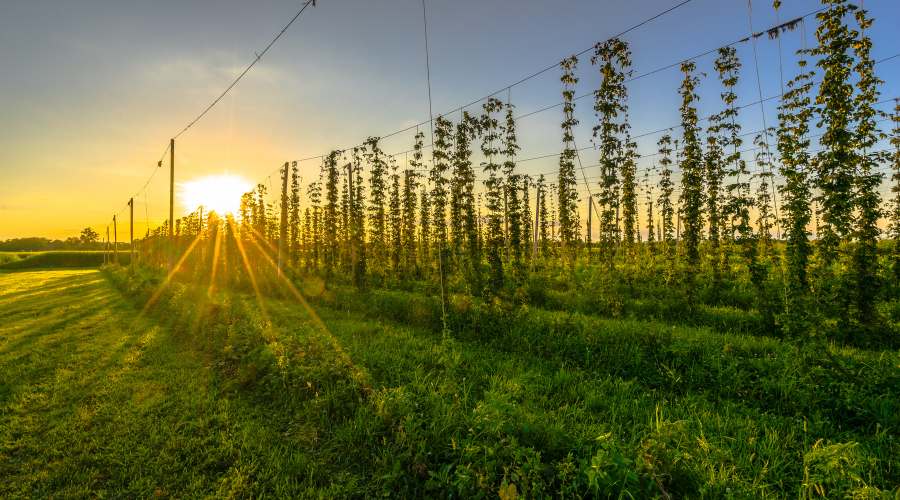As the craft beer industry continues to grow, so does the demand for locally sourced, high-quality ingredients.
One essential component of beer production is hops, which contribute to the flavor, aroma, and stability of the final product.
If you’re considering starting a hop farm to meet the increasing demand, this blog post will provide a comprehensive guide to help you begin your journey.
From understanding hop plant requirements to marketing your final product, we’ll cover everything you need to know to successfully start a hop farm.
Understanding Hops and Their Requirements
Hop plant overview
Hops (Humulus lupulus) are perennial climbing plants belonging to the Cannabaceae family.
The plant consists of a crown, rhizomes, and a vertical stem called a bine.
The bine produces flowers called cones, which contain lupulin glands that house essential oils and acids responsible for the characteristic bitterness, flavor, and aroma in beer.
Climate and soil requirements
Hops thrive in temperate climates, with ideal growing temperatures ranging between 60°F and 70°F.
They require about 15 hours of sunlight during the summer months, making them well-suited for regions with long daylight hours.
Hops grow best in well-draining, loamy soils with a pH level between 6.0 and 7.5.
Water and nutrient needs
Hops are relatively heavy water users, requiring around 1.5 inches of water per week during the growing season.
Drip irrigation systems are preferable to overhead watering, as they reduce the risk of disease.
Hops also require a balanced supply of nutrients, with nitrogen, phosphorus, and potassium being the primary elements.
Regular soil testing will help you determine the appropriate fertilizers and amendments to use.
Choosing the Right Hop Varieties
Popular hop varieties and their characteristics
Numerous hop varieties are available, each with unique properties that influence the final beer product.
Some popular varieties include Cascade, Centennial, Chinook, and Citra.
These varieties differ in terms of bitterness, flavor, and aroma profiles, as well as resistance to pests and diseases.
Factors to consider when choosing a variety
- Market demand: Research current market trends and speak with local breweries to understand which hop varieties are in high demand.
- Flavor profile and brewing use: Choose varieties that complement the beer styles being produced by your target market.
- Disease resistance: Opt for varieties with strong resistance to common hop diseases such as downy mildew and powdery mildew.
Sourcing quality hop rhizomes or plants
Purchase hop rhizomes or plants from reputable nurseries or suppliers, ensuring that they are free from pests and diseases.
It’s crucial to choose healthy and vigorous plants to maximize yield and minimize the risk of introducing diseases to your farm.
Planning and Designing Your Hop Farm
Estimating the size of your hop yard
The size of your hop yard will depend on factors such as the number of varieties, anticipated market demand, and available resources.
A small hop yard may range from a quarter to a full acre, while commercial-scale hop farms can span several acres.
Selecting the right trellis system
Types of trellis systems: The most common trellis system for hop farming is the V-trellis, which consists of vertical poles supporting horizontal cables.
Other options include the hedgerow and the low trellis system. Each system has its advantages and disadvantages in terms of installation cost, labor requirements, and yield potential.
Materials and installation: Pressure-treated wood, metal poles, and high-tensile wire are common materials used for trellis construction.
Installing a trellis system is labor-intensive and may require the assistance of professionals or specialized equipment.
Spacing and layout considerations
Proper spacing between plants is crucial for optimal growth and disease prevention.
A typical spacing arrangement for hops is 3.5 feet between plants within a row and 14 feet between rows. This allows for adequate airflow and sunlight exposure, promoting healthy growth.
Integrating irrigation and fertigation systems
Design your irrigation system to accommodate the water needs of your hop plants while minimizing water waste.
Drip irrigation is the preferred method due to its efficiency and ability to deliver water directly to the plant roots.
Incorporate a fertigation system to deliver nutrients to your plants through the irrigation lines, ensuring uniform distribution and uptake.
Planting and Growing Hops
Best time to plant hops
The optimal time to plant hops is in early spring, after the last frost has passed, and the soil has warmed.
This allows the plants to establish themselves before the growing season begins.
Proper planting techniques
Plant hop rhizomes or plants in well-prepared soil, ensuring that the roots are covered with 1-2 inches of soil.
Water the plants immediately after planting and maintain consistent moisture levels throughout the growing season.
Training and pruning hops
As hop bines grow, they must be trained onto the trellis system to encourage vertical growth.
Select the strongest bines for each plant and wind them clockwise around the support strings. Prune the lower leaves and shoots to promote airflow and reduce the risk of disease.
Pest and disease management
Implement an integrated pest management strategy to protect your hop plants from pests and diseases.
Regular scouting, preventative measures, and the use of organic or chemical treatments when necessary can help maintain the health of your plants.
Harvesting and Processing Hops
Determining the optimal harvest time
The ideal time to harvest hops varies depending on the variety and growing conditions.
Monitor the hop cones for signs of maturity, such as a papery texture, strong aroma, and the presence of yellow lupulin glands. A general guideline is 4-6 weeks after flowering.
Harvesting techniques and equipment
Harvesting can be done manually or mechanically, depending on the size of your hop yard.
Manual harvesting involves cutting the bines from the trellis and removing the cones by hand.
Mechanical harvesting uses specialized equipment to strip the cones from the bines and collect them in a hop picker.
Drying and curing hops
Proper drying and curing are essential for preserving the quality of your hops. Hops can be dried using oast houses, kilns, or air circulation systems.
The ideal moisture content for dried hops is 8-10%.
Packaging and storage tips
Store your dried hops in vacuum-sealed bags or airtight containers to prevent oxidation and preserve their freshness. Keep them in a cool, dark place, ideally at temperatures below 40°F.
Selling Your Hops and Building a Market Presence
Identifying potential buyers
- Local breweries and homebrewers: Establish relationships with local breweries and homebrewing communities, offering them a consistent supply of high-quality hops.
- Wholesale distributors: Partner with hop distributors to reach a broader market and expand your sales opportunities.
Creating a brand and marketing your hops
- Logo and packaging design: Develop a unique and attractive logo and packaging design that reflects the quality of your hops and captures your target audience’s attention.
- Social media and online presence: Utilize social media platforms, a website, and other online resources to showcase your hop farm, share updates, and connect with potential buyers.
Pricing strategies and negotiating contracts
- Research market prices: Stay informed about current hop prices and industry trends to ensure your pricing is competitive and reflects the quality of your product.
- Volume discounts and incentives: Offer volume discounts or other incentives to encourage larger orders and build long-term relationships with your buyers.
- Contracts: Consider negotiating contracts with breweries or distributors to secure a consistent demand for your hops and stabilize your income.
Ongoing Management and Expansion
Seasonal tasks and responsibilities
Stay organized and proactive by understanding and planning for the seasonal tasks involved in hop farming.
These tasks may include soil testing, planting, training, pruning, pest management, harvesting, and processing.
Record-keeping and data analysis
Maintain detailed records of your hop farm operations, including planting dates, varieties, yields, expenses, and sales.
Analyzing this data over time will help you make informed decisions regarding farm management and expansion.
Expanding your hop farm or diversifying your crops
As your hop farm becomes established and successful, consider expanding your operation or diversifying your crops. This may involve adding new hop varieties, increasing the size of your hop yard, or incorporating other crops to mitigate risk and maximize profits.
Conclusion
Starting a hop farm can be a rewarding and profitable venture for those with a passion for agriculture and the brewing industry.








